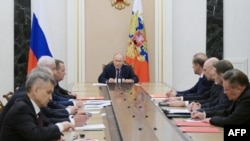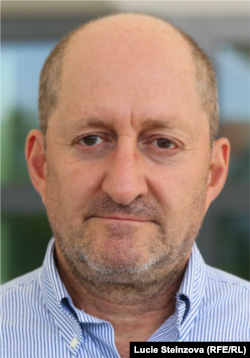
I'm Steve Gutterman, the editor of RFE/RL's Russia/Ukraine/Belarus Desk.
Welcome to The Week In Russia, in which I dissect some of the key developments in the country and in its war against Ukraine, and some of the takeaways going forward. To subscribe, click here.
President Vladimir Putin rattles Russia’s nuclear sabers once again, but analysts say it’s more signals than substance. And as Moscow’s war against Ukraine heads toward winter, the Kremlin seeks to fill the ranks amid grinding territorial gains and massive human losses.
Here are some of the key developments in Russia over the past week and some of the takeaways going forward.
Sending Signals
When Russia wants to keep something secret, restrict access, or withhold information, it does so: Kremlin meetings are held behind closed doors when the state sees fit, their true content hidden behind bland statements that provide few clues to what was actually said, done, or decided.
Putin’s administration sometimes even lies about the timing of meetings or whether they took place at all, releasing footage taken at a previous date and passing it off as current.
But when the Kremlin wants a meeting to be seen -- by Russians and by leaders, legislators, and laypeople around the world -- it spares no effort to make that happen.
Take the September 25 meeting of the presidential Security Council: The pertinent part was televised, perhaps counterintuitively for a body that is charged with advising Putin on the sensitive matter of national security.
In this case, the specific issue was Russia’s nuclear doctrine, which sets out the circumstances under which Moscow reserves the right to use nuclear weapons. Putin used the meeting to announce what he indicated would be imminent adjustments to this document -- changes, his remarks implied, that would lower Russia’s threshold for nuclear weapons use.
As a public spectacle, the meeting was less dramatic than one he held on February 21, 2022, as part of a series of moves meant to set the stage for the full-scale invasion of Ukraine that he launched less than 72 hours later -- and to justify it in advance. But the messaging was clear.
And when the meeting ended, the messaging did not. The next day, Putin’s spokesman said something that was already clear as day: that the Russian leader’s remarks were meant to be a signal to the West as the United States and other NATO nations consider allowing Kyiv to use the longer-range weapons they supply to strike military targets deep inside Russia.
'Radioactive Ash'
In his speech to the UN General Assembly on September 28, Russian Foreign Minister Sergei Lavrov waved the nuclear cudgel again. “I’m not going to talk here about the senselessness and the danger of the very idea of trying to fight to victory with a nuclear power, which is what Russia is,” he said – doing precisely what he claimed he would not do.
Putin’s remarks were the latest in a series of reminders that Russia possesses nuclear weapons and warnings that it will use them if necessary, ranging from convoluted comments to echoes of the infamous remark by a state television news show host who said in 2014 that Russia was the only country “capable of turning the United States into radioactive ash.”
The 2014 remark came as Russia was cementing its control over Ukraine’s Crimea region following an armed occupation -- and it shows that Moscow’s nuclear saber-rattling began long ago. But the drumbeat of warnings has grown louder and faster since Putin launched the full-scale invasion of Ukraine in 2022 – and soon found that that his expectations of a quick victory were badly misplaced.
Of course, actual changes in a doctrine differ from mere comments. Still, though, many analysts say Putin’s proposals -- even if they are made official soon, as expected -- amount to more signaling than substance.
For one thing, the proposed changes wouldn’t change much, analysts said.
While Putin added specifics and details, "I did not see anything fundamentally new,” Nikolai Sokov, a former Russian diplomat and arms-control negotiator now with the Vienna Center for Disarmament and Nonproliferation, told RFE/RL a day after the Security Council meeting.
"It represents a signal, a warning to NATO, as NATO continues to contemplate whether Western weapons should be used for long-range strikes," Sokov said.
A 'Cry For Attention'
Putin’s remarks should be seen in the context of the many previous nuclear warnings since the start of the full-scale invasion, Hans Kristensen, director of the Nuclear Information Project at the Federation of American Scientists, wrote in a blog post for Russia Matters, a project of the Belfer Center for Science and International Affairs at the Harvard Kennedy School of Government.
“He made them in public, so they are obviously intended to influence Western support of Ukraine and public opinion. Whether the adjustments will change how the Russian military would actually use nuclear weapons is another question. This creates a credibility problem for Putin: for the adjusted doctrine to be credible and impress his intended audience in the West, they will have to believe he would actually carry through with the nuclear threat. But he has issued so many red lines that the latest change almost sounds like a desperate cry for attention,” he wrote.
“Escalating to nuclear use in response to anything happening in the Ukraine war does not seem credible because it wouldn’t help Russia’s war aims and could trigger a direct military clash with NATO that would be much more costly to Russia,” Kristensen added.
Author and analyst Mark Galeotti said the changes may be tailored in part to a putative future time following a cease-fire in Ukraine.
“My suspicion is…we're talking about a degree of Russian game planning for a potential post cease-fire world,” he told RFE/RL. “Remember, if there's a cease-fire, the Russians want to freeze this as long as possible, and, of course, reserve to themselves the right to break that cease-fire whenever they think the correlation of forces in there is in their advantage.”
But Moscow also wants to ensure that Ukraine does not do the same.
“So, I think inserting this little clause is a way of deterring Kyiv, maybe, but certainly Washington…by more or less saying, ‘If you're backing Ukraine, and Ukraine in the future launches…an attempt to retake occupied territories -- possibly, just possibly, we will consider that as crossing the nuclear threshold with all the implications that involves,’” Galeotti said.
'Growing Pressure'
At the moment, though, a cease-fire seems like a distant prospect, despite what The Financial Times described as “growing pressure [on President Volodymyr Zelenskiy] from Western partners to find a path toward a negotiated settlement, even if there is skepticism about Russia’s willingness to enter talks any time soon and concern that Ukraine’s position is too weak to secure a fair deal right now.”
As its forces press forward in the Donbas, where they captured the city of Vuhledar this week, the Russian state is making multipronged efforts to keep on funding the full-scale invasion and bring in soldiers to replace the massive numbers of men it continues to lose at a fast rate.
Draft budget documents published this week indicate that Russian military spending will increase by 25 percent in 2025, accounting for nearly one-third of total expenditures and reaching 6.3 percent of gross domestic product (GDP), a record high since the Cold War.
According to Reuters, about 10 percent of defense spending “will go to military personnel payments, which have also hit a post-Soviet high with the minimum annual wage in the first year of service at the front line reaching 3.25 million rubles” -- $34,000 -- if the soldier survives that long.
Early And Often?
The government is also expanding and formalizing its efforts to bring Russians who have been convicted or face criminal prosecution into the fighting. For that drive, it is using a combination of incentives and pressure: Prisoners’ rights advocate Olga Romanova told Current Time that worsening conditions in prisons and pretrial jails are used as a tool to pressure inmates, suspects, and defendants into signing military contracts.
Meanwhile, the state has stepped up its efforts to improve a demographic situation that the war has made all the more dire, including by pressing for more babies. In several regions, authorities are planning cash payments for women who give birth in their early 20s -- or earlier.
Russia’s nuclear saber-rattling is a near-constant part of the diplomacy, for want of a better word, surrounding its war against Ukraine. It tends to grab headlines, drawing attention away from the everyday horror Russia is wreaking by raising alarms about an even larger catastrophe.
Civilians are being killed on a daily basis as Russian rockets, shells, bombs, and drones strike shops, apartment buildings, and other places where people are trying to lead their lives in the midst of an invasion.
On October 1, for example, a strike on the center of Kherson, a southern city that Ukraine recaptured from Russian forces in November 2022, killed at least six people, Ukrainian officials and media reports said.
In a village near Pokrovsk, a strategic city in the Donbas that Russia has been trying to take for months, a woman working at a roadside shop was killed in Russian shelling on September 28, officials said.
“That’s my daughter,” her father, Mykola, said as he sat beside her blanket-covered body after the attack. She left a 14-month-old son.
“I don’t want to live,” Mykola said.
That's it from me this week.
If you want to know more, catch up on my podcast The Week Ahead In Russia, here on our site or wherever you get your podcasts (Apple Podcasts, Spotify, Pocket Casts).
Yours,
Steve Gutterman
P.S.: Consider forwarding this newsletter to colleagues who might find this of interest. Send feedback and tips to newsletters@rferl.org.
